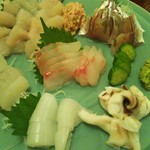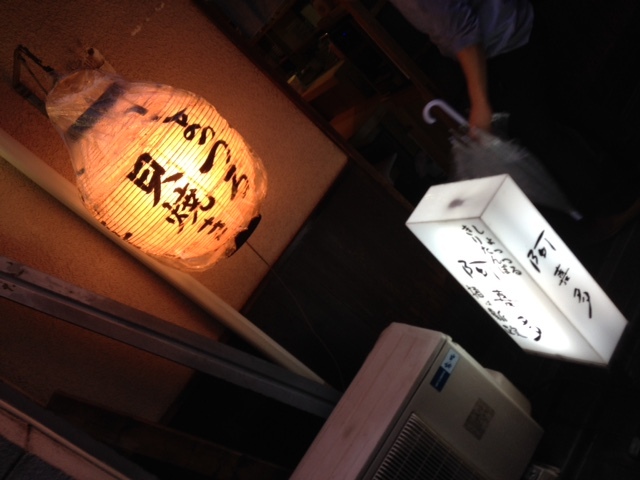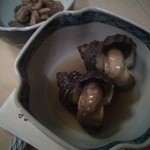
阿喜多
Akita ◆ あきた
3.09
Shinbashi, Shiodome
「Regional Cuisine」
8,000-9,999円
--
Opening hours: 17:00-22:30
Rest time: Saturdays, Sundays, and holidays Business hours and holidays are subject to change, so please check with the store before visiting.
東京都港区新橋3-11-5 新橋DXビル 1F
Photos
(20)




















Details
Reservation Info
can be reserved
Payment Method
Cards accepted
(JCB, AMEX, Diners)
Number of Seats
20 seats
Private Dining Rooms
None
Small room for about 4 people
Smoking and Non-Smoking
Smoking is permitted in all seats. As the Law Concerning Measures Against Passive Smoking (Revised Health Promotion Law) has been in effect since April 1, 2020, please check with the restaurant prior to your visit as the information may differ from the latest information.
Parking
None
Nearby toll parking: New Shinbashi Building parking lot, 2-16-1 Shinbashi, accommodates 200 cars, etc.
Facilities
Counter seating available, tatami room available
Drink
Sake available
Dishes
Focus on fish dishes
Comments
(11)
SOUL SURVIVOR
4.00
I went to Akita cuisine restaurant Akita-san, located behind Ringer Hut in Shinbashi. It has a cozy atmosphere more like a small traditional Japanese restaurant than an izakaya. The place is small with counter seats, table seats, and a raised tatami area, mostly frequented by elderly customers. There is a TV on the wall. We had a sashimi platter, simmered taro, grilled shirako, and kiritanpo hot pot. I chose a black label bottled beer (medium size) as you can choose the brand freely. The beer was served in a small glass, perfect for the older generation. The appetizers were tarako simmered in soy sauce and sesame tofu, both with a comforting taste. The sashimi platter came first, with kawahagi served with liver sauce and sea bream and squid with regular soy sauce. I switched to sake (Takashimizu) to pair with the sashimi. The liver sauce of kawahagi was rich in flavor, making the sake go down smoothly. Next was the simmered taro, cut in large pieces with a strong yuzu flavor, offering a gentle taste. The grilled shirako came in a set of three, cooked simply with salt to bring out its creamy flavor. The main dish was kiritanpo hot pot, a luxurious hot pot with plenty of leeks, Hinai-jidori chicken gizzard and thigh meat. The soup was rich in the natural flavors of the ingredients, making additional seasoning unnecessary. The mushrooms and kiritanpo were cooked perfectly in the pot. We ended the meal with pickled vegetables and rice porridge. It was a delicious meal. I hope the restaurant continues to prosper. Thank you for the wonderful meal.




ゆっとり世代
3.00
The master of the restaurant is quiet and very pleasant, while the hostess seems to take pride in running the place in Shinbashi for many years. The food was delicious and they surprisingly had a variety of drinks. They mentioned that they might be closing the restaurant in a few years, so I would like to visit again.
harley0208
4.00

ryh132206
4.50
The restaurant is quite old, but the taste is excellent. Starting with fresh sashimi, they also offer local specialties like kiritanpo, shottsuru, and authentic blowfish dishes. The taste was a hit after a long time.
jchxj4660517
3.20
The food is delicious but a bit expensive for two people at 16,500 yen. The kiritampo hot pot is tasty.
kenichi1963
3.60
The atmosphere is nice!
kanamilk
3.90
"We've been running this place for 50 years already, and we're both considered elderly now," the landlady said as she handed us hot towels. She explained that they had taken over the shop from the previous owner and had been running it together for five decades. The small restaurant was located in a narrow alley in Shinbashi 3-chome. Inside, there were counter seats, two four-person tables, and a raised tatami area that could accommodate around six people. Hanging above the entrance were frames with the words "Akita Regional Cuisine Akita" and "Sake is Shinsei." It was mentioned that these characters were written by a famous calligrapher with ties to Akita. It was clear that they had been preserving the flavors of Akita in this area for a long time. When we entered, a lively group was enjoying a hot pot at the raised tatami area, using a gas stove to cook the kiritanpo hot pot. Intrigued by the menu, we noticed the words "Shottsuru" next to kiritanpo. When we asked the landlady what it was, she explained that it was a type of hot pot broth made with shottsuru. Shottsuru hot pot is a specialty of Akita. We decided to order it, and the landlady informed us that it was priced at 3,000 yen per person, with a generous amount of fish and vegetables. She suggested that two portions would be enough for three people. She also showed us a large hatahata fish that would be included in each serving, emphasizing that it was only available from December to January. Intrigued by the unique offerings, we ordered two servings of the hot pot. While waiting for the hot pot to be prepared, we enjoyed some complimentary dishes such as simmered tarako and fugu, as well as a grilled hatahata fish. The landlady served us High Kiyomizu, a famous Akita sake that they sourced directly from the brewery. The fugu simmered dish was beautifully presented and had a delicate, transparent appearance, reflecting its refined taste. The grilled hatahata fish had a plump belly filled with eggs, which burst with flavor when eaten. Despite concerns about purine content, we couldn't resist the half-cooked eggs, which were rich in umami. The fish was also fatty and delicious. It was clear that such high-quality hatahata fish could only be found in a restaurant like this. As we savored the hatahata and fugu dishes, the landlady brought a red-hot pot to our table. She explained that while the kiritanpo hot pot was cooked with gas, the shottsuru hot pot was prepared using charcoal. She carefully poured the shottsuru broth into the pot, which was placed on top of scallop shells to prevent it from cracking. The broth was brought to a boil, and we added in the ingredients: diced hatahata fish, cod milt, whale skin, tofu, green onions, napa cabbage, shimeji mushrooms, enoki mushrooms, chrysanthemum greens, and shiitake mushrooms, as well as the abundant hatahata eggs. The shottsuru broth enhanced the flavors of the ingredients, creating a paradise of umami in the pot. We couldn't help but enjoy the sake along with the delicious food. Once we had finished all the ingredients, the landlady asked if we wanted to add kiritanpo to the broth. While kiritanpo hot pot typically uses chicken broth, she suggested using the flavorful shottsuru broth to cook the kiritanpo, combining the umami of the ingredients with the kiritanpo. It was a delightful experience, and we were all thoroughly satisfied."




cure jah
3.20
During the daytime, there was heavy rain, so I thought I could get into a famous restaurant in Shinbashi without a reservation. I headed to Shinbashi to have a drink and went to the restaurant I had in mind... I was wrong... The popular restaurants were still busy despite the rain. I was wondering what to do when I suddenly remembered this place. I had passed by before and noticed that there were many elderly customers and it was quite lively, so I decided to go there. When I entered, the landlady welcomed me and showed me to a table. It seems like the husband and wife run the place, and it has a cozy and considerate atmosphere. The food is delicate and has the essence of Tohoku cuisine. Normally, I prefer izakaya menus, but the dishes here have a calming feeling and are good. In particular, the simmered mackerel was highly rated by me. The seasoning was delicate. The hot sake was quickly emptied! The sign outside the shop said "Shinsei," but they were complaining that they couldn't handle the demand due to the recent sake boom and Shinsei's popularity. I was prepared for the bill, but spending over 10,000 yen for two people in less than an hour... The personalities of the couple were also great. Thank you for the meal.




SOUL SURVIVOR
4.00
Visited Akita cuisine restaurant "Akita" seeking relaxation. Opted for the chef's choice menu again, which costs around 10,000 yen if you don't drink too much. Enjoyed various Akita dishes and Japanese sake while watching NHK, which was a heavenly experience. They have a good selection of bottled beers from major brands. Unfortunately, I had to skip the kiritanpo hot pot and grilled hata salt this time due to the timing of my visit. However, all the dishes served were delicious, starting from the delicious ezoconch with amazing broth to the thickly sliced bonito sashimi. The radish pickles were a great accompaniment to the sake. The Inaniwa udon as the finale was perfectly cooked and had a smooth texture, making it a delightful end to the meal. I felt grateful for being alive during this wonderful time. Thank you for the delicious meal. I sincerely hope they continue their business for a long time as a source of energy for tomorrow.




温芯の味
3.50
Located in Shinbashi Karasumori, this restaurant serves traditional Akita cuisine. Run by a couple, the warm atmosphere attracts customers. The restaurant has a counter, tables, and raised tatami seating. Their specialty is homemade kiritanpo, a slightly soft version that allows the flavors to seep in. The broth, rich in flavor, enhances the ingredients perfectly. Sashimi like kawahagi liver and flounder are a must-try. The hatatate is best during the peak season, with large, fatty pieces that satisfy. Pairing the dishes with Shinsei sake is recommended. This is a must-visit spot for delicious Akita cuisine.




suno2
4.50
A hidden gem in Shinbashi, a restaurant specializing in grilled scallop and kiritanpo hot pot run by the owner and his wife. The cozy establishment features a white wooden counter, two tables, and a small raised seating area in the back. They serve only fresh sashimi, including red sea cucumber with vinegar, simmered cod roe, and boiled white bai gai shellfish. The grilled scallops are cooked on a large shichirin charcoal grill using giant scallop shells. The shottsuru soup, mixed with grated daikon radish, is used to cook fish and vegetables slowly. It's important to keep an eye on the soup as it evaporates quickly and can lead to burning the pot. Enjoying the meal slowly with a glass of sake is a truly delightful experience. The soup absorbs all the flavors, creating a rich and concentrated taste. Finish off the meal by adding kiritanpo to soak up the remaining soup. The kiritanpo hot pot made with Hichin chicken broth is also highly recommended. I always end up ordering more hot pot because it's so satisfying!
Email Login